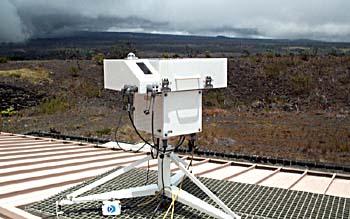
|
|
|
|
August 30, 2001
A weekly feature provided by scientists at the Hawaiian Volcano Observatory.
Ozone in our air - friend or foe? - depends on where

|
|
| Through an agreement between the USGS-Hawaiian Volcano Observatory, US EPA, and the NPS, a specially configured spectrophotometer measures potentially harmful ultraviolet B (UV-B) radiation as well as column amounts of ozone (O3), sulfur dioxide (SO2) and nitrogen dioxide (NO2) present in the atmosphere between the instrument and the sun. | large | | |
Several decades ago, a person who had an overly active imagination might have been described as being "out in the ozone." Now just where would that be? Well, ozone (O3) exists in two distinct layers in the Earth's atmosphere and is considered "good" or "bad," depending on where it is. The US EPA has coined a maxim to help us remember: "good up high - bad nearby."
The atmospheric layer where we live is known as the troposphere and extends from the surface of the Earth up to about 6 miles (10 km). Ozone in this layer is a bad pollutant; vehicles, power plants and factories emit air pollution that forms ground level O3. Ozone is a major component of urban smog and damages human health, vegetation, and many common materials like rubber, cloth, and paint. Although O3 concentrations on the Island of Hawai'i are generally very low, certain areas in urban Honolulu do occasionally exceed state health standards.
In contrast, "good" ozone resides in the stratosphere, the atmospheric layer that extends upward from about 6 to 30 miles (10 - 50 km). When traveling in a commercial jet, you are at the base of the stratosphere. Stratospheric O3 is important for protecting life on earth by absorbing much of the harmful ultraviolet sunlight radiation known as UV-B. Increases in UV-B exposure can lead to more cases of skin cancer, cataracts, and impaired immune systems. Also, damage to UV-B sensitive crops, such as soybeans, and marine organisms, could reduce food supplies.
Although ozone in the stratosphere is naturally produced and destroyed at a constant rate, humans are gradually tipping the balance by using ozone-depleting substances. The chemicals used in refrigerators, air conditioners, fire extinguishers and solvents can reach the stratosphere, where they are broken down and release chlorine and bromine molecules which destroy "good" O3. One chlorine or bromine molecule can destroy 100,000 ozone molecules, so O3 in the stratosphere is disappearing much faster than nature can replace it. Interestingly, explosive volcanoes contribute a minor amount of chlorine to the stratosphere- about 3 percent of the total, while humans contribute 82 percent. Gases from quieter eruptions, such as the current one at Kilauea, do not reach and affect stratospheric ozone.
The Hawaiian Volcano Observatory, through a cooperative project with the National Park Service and US EPA, measures the column of O3 between the ground and the sun, as well as the amount of harmful UV-B getting through to the Earth's surface. Data are collected using a sensitive spectrophotometer that carefully measures light of specific wavelengths. The HVO site is part of a nationwide network that is examining the effects of UV-B on the health of humans and other species. The network also contributes to an international effort to track the global distribution of stratospheric O3 depletion. At HVO this instrument also measures sulfur dioxide (SO2) and nitrogen dioxide (NO2), two gases that are released during and after lava is erupted.
The Earth's atmosphere is a fragile layer which protects life on earth from the damaging radiation from the sun. If the Earth were the size of soccer ball, then a layer of plastic food wrap around the ball would represent the troposphere, where we live. The stratosphere, where the good O3 resides, would be an additional 4 layers of plastic wrap. The good news is that there are things that we can all do to help keep the thin, fragile layers of our atmosphere healthy- so that we too can remain healthy. To learn how you can help minimize the production of "bad" O3 and help protect the "good" stratospheric ozone layer, check out the following web site: http://www.epa.gov/oar/oaqps/gooduphigh/#what
Eruption Update
Eruptive activity of Kilauea Volcano continued unabated at the Pu`u `O`o vent during the past week. Lava moves away from the vent toward the ocean in a network of tubes and descends Pulama pali in two separate areas. Lava continued to enter the ocean in the area east of Kupapa`u throughout the week and provided visitors to the viewing area a great show. On August 30, a small surface flow, originating from a breakout of the tube supplying the ocean entry, was within 150 m (500 ft) of the road leading to the viewing area. As a precautionary measure, the County closed the road. USGS personnel from HVO will continue to monitor the progress of the flow and will keep the County officials informed.
The public is reminded that the bench of the ocean entry area is extremely hazardous, with possible collapses of the new land. The steam cloud is extremely hot, highly acidic, and laced with glass particles. Swimming at the black sand beach of the bench can be a blistering or even deadly venture.
There were no earthquakes reported felt during the week ending on August.
![]()
The URL of this page is http://hvo.wr.usgs.gov/volcanowatch/01_08_30.html
Contact: hvowebmaster@hvo.wr.usgs.gov
Updated: September 4, 2001 (pnf)
